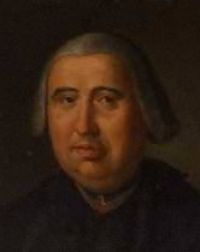

Italian composer and cello virtuoso. Born in Rome in 1704, he entered the service of the famous Cardinal Pietro Ottoboni in 1721. (Ottoboni was one of the great patrons of his generation. In Rome he sat in the Palazzo della Cancelleria, where he supported Arcangelo Corelli, the finest violinist of his generation, at his Monday night concerts called "academies," and where Corelli was introduced to Handel. When Corelli died in 1713, he left his estate, including his valuable pictures, to Cardinal Ottoboni, who distributed the sizable funds among Corelli's relations and erected Corelli's princely tomb in the Pantheon. Among Ottoboni's other protegés were Antonio Vivaldi and Antonio Caldara. When opera was banned in Rome, performances withdrew to Ottoboni's Cancelleria. His triumphal return to Venice in 1726 was celebrated with musical festivities that included a serenata Andromeda liberata, with arias contributed by various Venetian masters, including Vivaldi.) In 1722, Costanzi was appointed to the post of violincellist at S. Luigi dei Francesi in Rome. In 1740 he entered the service of Cardinal Trojano Acquaviva d"Aragona and, on the latter's death in 1752, the service of Cardinal Albani. He was also maestro di capella at various churches in Rome: Madonna di Loreto in 1742, and S. Marco e S. Maria in Vallicella the following year. In 1754 he was named assistant to Pietro Paolo Bencini, succeeding him as maestro di cappellaof the Cappella Giulia at his death in 1755. In 1760 he possibly also became maestro di cappella at the Collegio Germanico.
Constanzi's works include:
Operas: (all presented at Rome) L 'amor generoso (libretto Apostolo Zeno, 1721); Carlo Vagno (P. Ottoboni, 1729); Rosmene (G. Pulvini-Feliconi, 1739); Eupatra (1730); La Flora (1734); Il trionfo della pace (G. Melani; 1739); Il Vesuvio (1741); L'asilo delle virtù (1744); La speranza della Terra (1744); Enea in Cuma (1746); Amor prigioniero (G. Pizzi; 1752).
Oratorios: Oratorio a 6 S. Cecilia (1725); La SS Annunziata (1725); L'Adamo (1735); Desiderio del martirio di S. Antonio Abate (1739); Two Oratorios for l'Assunzione della Beatissima Vergine (1745; 1746); S. Pietro Vescovo d'Alessandria (1746); Gioas, Re di Giuda (1748); Oratorio for the Feast of the Blessed Girolamo Emiliano (1748); Esther (1753); Giuditta (1753); Giaele (1754); La morte d'Abel (1738).
Sacred works: "Per la festività del SS. Natale" (1728); Componimento sacro (1734); Componimento sacro fatto cantare sul Monte detto di S. Onofrio (1752); Componimento sacro (1757); Cantate for the SS. Natale; eight masses; various occasional cantatas, dedicated to Empress Elisabetta Cristina, wife of Charles III, the Austrian contender to the Spanish throne (1729), the duke of St. Aignon (1737), to Carlo di Borbone (1742), and the spectacle for the birthday of the Queen of the Two Sicilies (1745).
Instrumental works: Concerto for violoncello and violin; five sinfonias for violoncello solo; two Sonatas for violoncello solo and continuo; Sonata da camera for two violoncelli and corni da caccia.